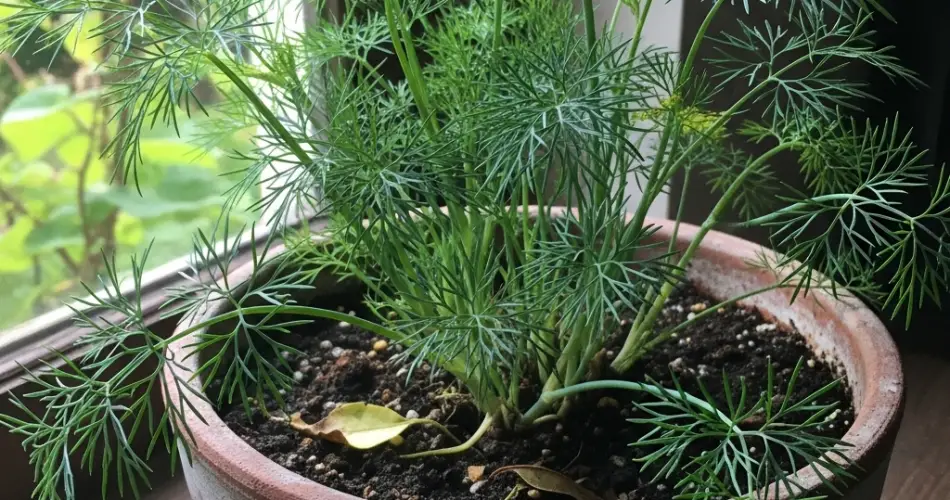Dill is a wonderfully aromatic herb cherished for its feathery leaves and unique flavor that enhances pickles, salads, seafood dishes, and soups. It is a fast-growing annual herb that thrives well in containers, making it ideal for gardeners with limited space such as balconies, patios, or kitchen windowsills.
Growing dill in pots allows you to have fresh leaves available quickly, and with the right potting practices, you can enjoy a lush, healthy plant that grows vigorously and produces flavorful foliage.
This article covers the best potting techniques to help you grow fast-growing dill successfully in containers.
Why Grow Dill in Pots?
Container gardening offers many advantages for dill cultivation:
-
Space Efficiency: Perfect for small gardens, balconies, or indoor herb stations.
-
Control Over Conditions: Manage soil quality, watering, and sunlight to optimize growth.
-
Mobility: Easily move pots to maximize sun exposure or shelter plants from harsh weather.
-
Quick Harvest: Dill grows rapidly, so container cultivation allows for swift access to fresh herbs.
Choosing the Right Pot for Dill
Selecting the right container is fundamental for dill’s fast and healthy growth:
-
Size: Dill has a moderately deep root system, so choose a pot that is at least 10 to 12 inches deep and wide enough to accommodate its spreading habit.
-
Material: Terracotta pots are excellent for breathability and moisture regulation. Plastic or ceramic pots can also work as long as drainage is sufficient.
-
Drainage: Ensure your pot has multiple drainage holes to prevent waterlogging, which can damage dill roots.
Soil Requirements
Dill prefers loose, well-draining, and fertile soil:
-
Use a quality potting mix rich in organic matter.
-
Amend the soil with compost to provide nutrients.
-
Avoid heavy or compacted soils that can hinder root growth.
Planting Dill
-
Sowing Seeds: Dill is typically grown from seed. Sow seeds about ¼ inch deep in the potting soil.
-
Spacing: Space seeds or seedlings approximately 6 to 8 inches apart to avoid overcrowding and allow good airflow.
-
Germination: Dill seeds usually sprout within 7 to 14 days under ideal conditions.
Light Requirements
Dill is a sun-loving herb:
-
Provide at least 6 to 8 hours of direct sunlight each day.
-
Position pots in sunny windowsills, patios, or balconies.
-
If growing indoors, consider supplemental grow lights to ensure adequate light exposure.
Watering Dill
Proper watering is essential for fast growth:
-
Keep the soil consistently moist but not soggy.
-
Water when the top inch of soil feels dry to the touch.
-
Avoid letting the soil dry out completely, as dill prefers steady moisture.
Fertilizing Potted Dill
Dill benefits from moderate feeding:
-
Use a balanced, water-soluble fertilizer diluted to half strength every 4 to 6 weeks.
-
Avoid over-fertilizing, which can promote excessive foliage growth with less flavor.
Supporting Fast Growth
-
Temperature: Dill grows best in temperatures between 60°F and 75°F (15°C to 24°C).
-
Air Circulation: Good airflow prevents fungal diseases and supports robust growth.
-
Pruning: Pinch back the tips to encourage bushier growth and prevent premature flowering.
Harvesting Dill
-
Begin harvesting once the plant reaches 6 to 8 inches tall.
-
Snip leaves as needed, cutting from the outer stems to allow new growth.
-
Harvest regularly to keep the plant producing fresh foliage.
-
If you want dill seeds, allow some flower heads to mature and dry before collecting seeds.
Common Problems and Solutions
-
Leggy Plants: Often due to insufficient sunlight; increase light exposure.
-
Yellowing Leaves: May result from overwatering or nutrient deficiency; adjust watering and fertilize appropriately.
-
Pests: Watch for aphids and caterpillars; treat infestations early with insecticidal soap.
-
Root Rot: Prevent by ensuring excellent drainage and avoiding overwatering.
Benefits of Growing Dill in Pots
-
Fresh Flavor: Enjoy fresh dill leaves for cooking anytime.
-
Fast Growing: Dill grows quickly, allowing for frequent harvests.
-
Aromatic: Adds a pleasant fragrance to your garden or kitchen.
-
Versatile Use: Dill leaves and seeds are both valuable in cooking and preserving.
Conclusion
Growing dill in pots is a rewarding way to have fresh, aromatic herbs on hand, even with limited garden space. By selecting the right container, using well-draining soil, providing ample sunlight, and watering properly, you can cultivate fast-growing dill plants that flourish.
With these best potting practices, your potted dill will thrive, offering fresh leaves and seeds to enhance your culinary creations throughout the growing season.



